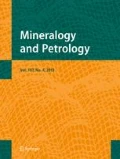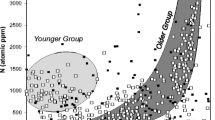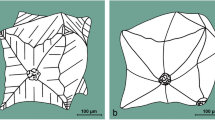Abstract
Yellow diamonds from the CH-7 (Chidliak) and the Misery (Ekati Mine) kimberlites in northern Canada are characterised for their nitrogen characteristics, visible light absorption, internal growth textures, and carbon isotope compositions. The diamonds are generally nitrogen-rich, with median N contents of 1230 (CH-7) and 1030 at.ppm (Misery). Normally a rare feature in natural diamonds, single substitutional nitrogen (C centres) and related features are detected in infrared absorption spectra of 64% of the studied diamonds from CH-7 and 87% from Misery and are considered as the major factor responsible for their yellow colouration. Episodically grown diamonds, characterised by colourless cores containing some nitrogen in the fully aggregated form (B centres) and yellow outer layers containing C centres, occur at both localities. Carbon isotope compositions and N contents also are significantly different in such core and rim zones, documenting growth during at least two temporally distinct events and involving different diamond forming fluids. Based on their nitrogen characteristics, both the yellow diamonds and yellow rims must have crystallized in close temporal proximity (<<1 Ma) to kimberlite activity at CH-7 and Misery.










Similar content being viewed by others
References
Banas A, Stachel T, Smit KV and Armstrong K (2017) Yellow and white diamonds from Qilalugaq kimberlites: two generations of diamond growth. 11IKC extended abstract#4536
Bursill LA, Glaisher RW (1985) Aggregation and dissolution of small and extended defect structures in type Ia diamond. Am Mineral 70:608–618
Cartigny P (2005) Stable isotopes and the origin of diamond. Elements 1:79–84
Chinn IL, Gurney JJ, Kyser KT (1998) Diamonds and mineral inclusions from the NWT, Canada. 7IKC addendum to extended abstracts
Clark CD, Davey ST (1984) One-phonon infrared absorption in diamond. J Phys C Solid State 17:1127–1140
Collins AT (2001) The colour of diamond and how it may be changed. J Gemmol 27(6):341–359
Collins AT, Mohammed K (1982) Optical studies of vibronic bands in yellow luminescing natural diamonds. J Phys C Solid State 15:147–158
Coplen TB, Böhlke JK, De Bièvre P et al (2009) Isotope-abundance variations of selected elements (IUPAC technical report). Pure Appl Chem 74:1987–2017
Davies G (1976) The a nitrogen aggregate in diamond-its symmetry and possible structure. J Phys C Solid State 9:L537–L542
Dobrinets IA, Vins VG, Zaitsev AM (2013) HPHT-treated diamonds. Springer-Verlag, Berlin Heidelberg, p 257
Dominion Diamond Mines (2017) Dominion Diamond announces positive results of Misery Deep pre-feasibility study and provides update on Fox Deep project at Ekati Mine. Retrieved from https://www.ddmines.com/dominion-diamond-announces-positive-results-of-misery-deep-pre-feasibility-study-and-provides-update-on-fox-deep-project-at-ekati-mine
Evans T, Harris JW (1986) Nitrogen aggregation, inclusion equilibration temperatures and the age of diamonds. IKC extended abstracts 4:386–388
Evans T, Qi Z (1982) The kinetics of the aggregation of nitrogen atoms in diamond. Proc R Soc Lond A 381:159–178
Evans T, Wild RK (1965) Plastic bending of diamond plates. Philos Mag 12:479–489
Gali A, Lowther JE, Deak P (2001) Defect states of substitutional oxygen in diamond. J Phys Condens Mat 13:11607
Gem Diamonds (2012) Gem diamonds half year 2012 results. Retrieved from https://www.gemdiamonds.com/downloads/2012/press/HY%20Report%202012%20Final.pdf
Goss JP, Briddon PR, Papagiannidis S, Jones R (2004) Interstitial nitrogen and its complexes in diamond. Phys Rev B 70:235208
Goss JP, Briddon PR, Hill V, Jones R, Rayson MJ (2014) Identification of the structure of the 3107 cm−1 H-related defect in diamond. J Phys Condens Mat 26:145801
Government of Western Australia (2015) Ellendale Diamond Mine. Retrieved from http://www.dmp.wa.gov.au/Environment/Ellendale-Diamond-Mine-19526.aspx
Hainschwang T, Notari F, Fritsch E, Massi L (2006) Natural, untreated diamonds showing the a, B and C infrared absorptions (“ABC diamonds”), and the H2 absorption. Diam Relat Mater 15:1555–1564
Hainschwang T, Notari F, Fritsch E, Massi L, Rondeau B, Breeding CM, Vollstaedt H (2008) HPHT treatment of CO2 containing and CO2-related brown diamonds. Diam Relat Mater 17:340–351
Hainschwang T, Fritsch E, Massi L, Rondeau B, Notari F (2012a) The C center isolated nitrogen-related infrared absorption at 2688 cm−1: perfect harmony in diamond. J Appl Spectrosc 79(5):737–743
Hainschwang T, Fritsch E, Notari F, Rondeau B (2012b) A new defect center in type Ib diamond inducing one phonon infrared absorption: the Y center. Diam Relat Mater 21:120–126
Hainschwang T, Fritsch E, Notari F, Rondeau B, Katrusha A (2013) The origin of color in natural C center bearing diamonds. Diam Relat Mater 39:27–40
Harlow GE (1998) The nature of diamonds. Cambridge University Press, pp 278
Harris JW, Hawthorne JB, Oosterveld MM, Wehmeyer E (1975) A classification scheme for diamond and a comparative study of South Africa diamond characteristics. Phys Chem Earth:765–783
Heaman LM, Pell J, Grütter HS, Creaser RA (2015) U-Pb geochronology and Sr/Nd isotope compositions of groundmass perovskite from the newly discovered Jurassic Chidliak kimberlite field, Baffin Island, Canada. Earth Planet Sci Lett 415:183–199
Hogberg K, Stachel T, Stern RA (2016) Carbon and nitrogen isotope systematics in diamond: different sensitivities to isotopic fractionation or a decoupled origin? Lithos 265:16–30
Howell D, O’Neill CJ, Grant KJ, Griffin WL, Pearson NJ, O’Reilly SY (2012) μ-FTIR mapping: distribution of impurities in different types of diamond growth. Diam Relat Mater 29:29–36
Jones R, Briddon PR, Öberg S (1992) First-principles theory of nitrogen aggregates in diamond. Philos Mag Lett 66:67–74
King JM, Shigley JE, Gelb TH, Guhin SS, Hall M, Wang W (2005) Characterization and grading of natural-color yellow diamonds. Gems Gemol 41:88–115
Kirkley MB, Gurney JJ, Otter ML, Hill SJ, Daniels LR (1991) The application of C isotope measurements to the identification of the sources of C in diamonds: a review. Appl Geochem 6:477–494
Kopylova MG, Tso E, Ma F, Liu J, Pearson DG (2017) Peridotite xenoliths of the Chidliak kimberlite province (NE Canada): the North Atlantic cratonic mantle with recent thermal and Ti-Na metasomatic disturbance. 11IKC extended abstract#4578
Krebs MY, Pearson DG, Stachel T, Stern RA, Nowicki T, Cairns S (2016) Using microdiamonds in kimberlite diamond grade prediction: a case study of the variability in diamond population characteristics across the size range 0.2 to 3.4 mm in misery kimberlite, Ekati mine, NWT, Canada. Econ Geol 111:503–525
Lai MY (2018) Spectroscopic analysis of yellow diamonds. MSc thesis, University of Alberta, pp 123
Lawson SC, Fisher D, Hunt DC, Newton ME (1998) On the existence of positively charged single-substitutional nitrogen in diamond. J Phys Condens Mat 10:6171–6180
Leahy K, Taylor WR (1997) The influence of the Glennie domain deep structure on the diamonds in Saskatchewan kimberlites. Geol Geofiz 38:451–460
Liggins S (2010) Identification of point defects in treated single crystal diamond. PhD thesis, University of Warwick, pp 241
Ludwig KR (2003) Using Isoplot/ex, version 3.00: a geochronological toolkit for Microsoft excel. Berkeley geochronology center special Publication, 4, pp 71
Nailer SG, Moore M, Chapman J, Kowalski G (2007) On the role of nitrogen in stiffening the diamond structure. J Appl Crystallogr 40:1146–1152
Nowicki T, Crawford B, Dyck D, Carlson J, McElroy R, Oshust P, Helmstaedt H (2004) The geology of kimberlite pipes of the Ekati property, Northwest Territories, Canada. Lithos 76:1–27
Nowicki T, Coopersmith H, Pilotto D (2016) Mineral resource estimate for the Chidliak project, Baffin Island, Nunavut. Technical report, pp 239. Retrieved from https://www.pdiam.com/assets/docs/technical-reports/msc16_006r-mineral-resource-estimate-for-the-chidliak-project_2016-06-16.pdf
Salustro S, Pascale F, Mackrodt WC, Ravoux C, Erba A, Dovesi R (2018) Interstitial nitrogen atoms in diamond. A quantum mechanical investigation of its electronic and vibrational properties. Phys Chem Chem Phys 20:16615–16624
Shcherbakova MY, Nadolinnyi VA, Sobolev EV (1978) The N3 center in natural diamonds, from ESR data. J Struct Chem 19(2):261–269
Shigley JE, Breeding CM (2013) Optical defects in diamond: a quick reference chart. Gems Gemol 49:107–111
Shigley JE, Breeding CM (2015) Visible absorption spectra of colored diamonds. Gems Gemol 51:41–43
Smit KV, Shirey SB, Wang W (2016) Type Ib diamond formation and preservation in the west African lithospheric mantle: re–Os age constraints from sulphide inclusions in Zimmi diamonds. Precambrian Res 286:152–166
Sobolev VS (1980) New proof on very deep subsidence of eclogitized crustal rocks. In Dokl Akad Nauk SSSR 250:683–685
Stachel T, Harris JW (2009) Formation of diamond in the Earth’s mantle. J Phys Condens Mat 21:364206
Stern RA, Palot M, Howell D, Stachel T, Pearson DG, Cartigny P, Oh A (2014) Methods and reference materials for SIMS diamond C- and N-isotope analysis. CCIM research report 14-01. University of Alberta, education and research archive. Retrieved from http://hdl.handle.net/10402/era.38738
Sumida N, Lang AR (1981) Cathodoluminescence evidence of dislocation interactions in diamond. Philos Mag A 43:1277–1287
Taylor WR, Jaques AL, Ridd M (1990) Nitrogen-defect aggregation characteristics of some Australasian diamonds: time-temperature constraints on the source regions of pipe and alluvial diamonds. Am Mineral 75:1290–1310
Taylor WR, Canil D, Milledge HJ (1996) Kinetics of Ib to IaA nitrogen aggregation in diamond. Geochim Cosmochim Ac 60:4725–4733
Titkov SV, Shiryaev AA, Zudina NN, Zudin NG, Solodova YP (2015) Defects in cubic diamonds from the placers in the northeastern Siberian platform: results of IR microspectrometry. Russ Geol Geophys 56:354–362
Xia X (2018) Mineral inclusions in diamonds from Chidliak (Nunavut, Canada): constraining the diamond substrates. MSc thesis, University of Alberta, pp 100
Yokota Y, Kotsuka H, Sogi T, Ma JS, Hiraki A, Kawarada H, Matsuda K, Hatada M (1992) Formation of optical centers in CVD diamond by electron and neutron irradiation. Diam Relat Mater 1:470–477
Zaitsev AM (2001). Optical properties of diamond: a data handbook. Springer Berlin Heidelberg, pp 502
Acknowledgments
The authors thank Dominion Diamond Mines and Peregrine Diamonds Ltd. for the generous provision of diamonds for this study. Without the help of Jon Carlson, Kimberly Ferguson (both Dominion Diamond Mines), Herman Grütter and Jennifer Pell (both Peregrine Diamonds Ltd.), this study would not have been possible. We thank reviewers Eloïse Gaillou, Thomas Hainschwang and Yaakov Weiss, and editor Lutz Nasdala, for constructive comments that greatly improved the paper. MYL acknowledges a bursary through the Diamond Exploration Research Training School (DERTS) funded by the Natural Sciences and Engineering Research Council of Canada (NSERC) Collaborative Research and Training Experience (CREATE) program. TS received additional funding for the project through an NSERC Discovery grant and the Canada Research Chairs program.
Author information
Authors and Affiliations
Corresponding author
Additional information
Editorial handling: L. Nasdala
Publisher’s note
Springer Nature remains neutral with regard to jurisdictional claims in published maps and institutional affiliations.
Rights and permissions
About this article
Cite this article
Lai, M.Y., Stachel, T., Breeding, C.M. et al. Yellow diamonds with colourless cores – evidence for episodic diamond growth beneath Chidliak and the Ekati Mine, Canada. Miner Petrol 114, 91–103 (2020). https://doi.org/10.1007/s00710-020-00693-0
Received:
Accepted:
Published:
Issue Date:
DOI: https://doi.org/10.1007/s00710-020-00693-0




